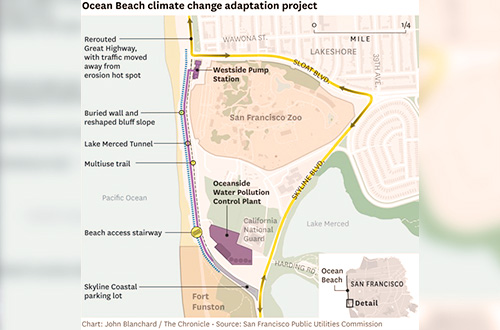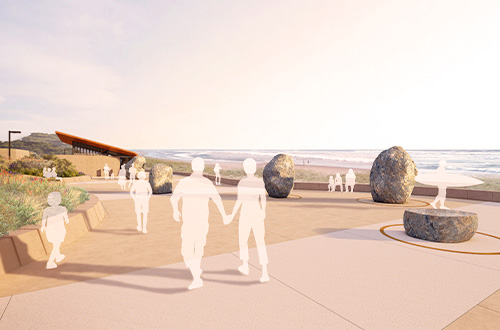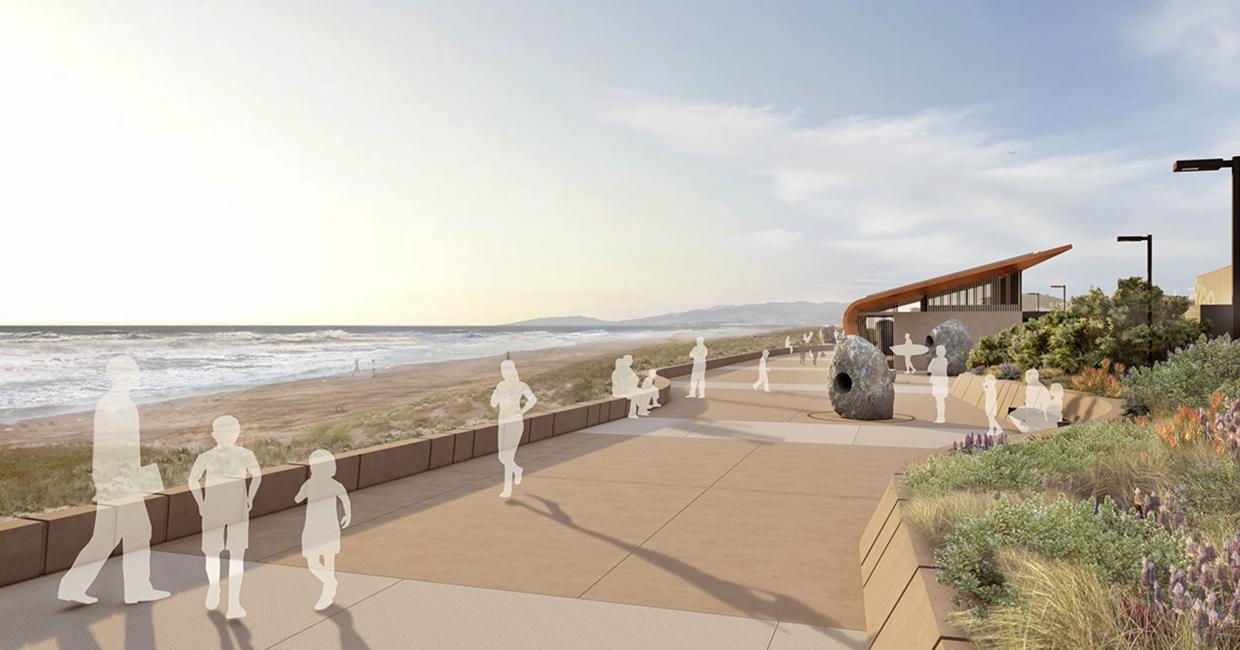Those who have experienced the western coastline of San Francisco will agree, Ocean Beach is a community treasure. But it is also a challenging environment, impacted by storm-driven waves and suffering from climate-induced erosion of the coastal bluffs. South of Sloat Boulevard, erosion has also undermined and damaged beach parking lots, stormwater drainage facilities and the Great Highway itself. Storms continue to threaten critical wastewater infrastructure and limit public shoreline access and recreational opportunities.
At South Ocean Beach, shoreline erosion is threatening the most seaward component of the SFPUC’s combined sewer system — the Lake Merced Tunnel, a fourteen-foot diameter pipe located under the Great Highway. With rising sea levels and more intense storms, erosion is only expected to get worse, which amplifies the urgency to protect coastal infrastructure, habitats, and the beach itself.

Adapting to the Changing Environment
The Ocean Beach project is the first major climate change adaptation project in San Francisco. When complete, it will create over a mile of new seaside trail; improve coastal access, recreation, and habitat at South Ocean Beach; and protect vital public wastewater and recycled water infrastructure.
Project elements include constructing a buried seawall to protect a pump station and the new recycled water facility. Other elements include rerouting Great Highway traffic at Sloat Boulevard away from the narrowest part of the beach, building a multi-use public trail with sweeping Pacific Ocean views where the highway is now, and improving beach health through the replacement of sand.
“These long-term improvements will protect the vital wastewater infrastructure at risk,” states Anna M. Roche, Project Manager for the SFPUC Ocean Beach Climate Change Adaptation Project, “but equally important, this project offers an opportunity for the City to drastically improve public use and accessibility along the Great Highway south of Sloat Boulevard.”
The proposed improvements include the construction of a multi-use trail, beach access stairway, coastal access parking, and public restroom. The current schedule estimates construction will begin in late 2024 and last for four years.

Guided by the Ocean Beach Master PlanThe Ocean Beach Project design is guided by shoreline management concepts recommended by The Ocean Beach Master Plan, a collaborative vision for San Francisco’s western coast, led by the San Francisco Bay Area Planning and Urban Research Association (SPUR), which brought together community members, city agencies, the San Francisco Zoo, California Coastal Commission, the National Park Service and the Army Corps of Engineers.
The Master Plan presents six key moves that are organized by geographical reach and designed to be implemented incrementally over a period of decades. This project focuses on South Ocean Beach and includes two of the six key moves: the removal of the Great Highway between Sloat and Skyline Boulevards, and in its place construct a multipurpose coastal protection, restoration, and access system.
Major Milestones Ahead
2023 is a pivotal year. In September, the SF Planning Commission certification of the Final Environmental Impact Report was followed by project approval by the SFPUC Commission on October 10, 2023. In late 2023 and early 2024, the Board of Supervisors will be asked to take action to close the Great Highway between Sloat and Skyline Boulevards, which will allow the project to proceed with implementing the changes below over the next several years.
Specific project objectives and components include:
- Protect Critical Infrastructure:
- Construct a buried wall to protect wastewater infrastructure and recycled water facilities from shoreline erosion, and cover with sand every year, as needed, to maintain a wider beach.
- Preserve and Enhance Coastal Access, Recreation, and Habitat:
- Construct a multi-use trail, beach access stairway, restrooms, and complete Americans with Disabilities Act (ADA) access improvements along Ocean Beach north of Sloat Boulevard;
- Remove the revetments and debris previously placed to reduce erosion, reshape the bluff to increase accessible open space area, and plant native vegetation.
- Continue beach nourishment (sand replenishment) as needed.
- Implement Roadway, Safety & Parking Changes:
- Reroute Great Highway traffic away from the beach between Sloat and Skyline boulevards
- Improve Adjacent Intersections: Improve the intersections at Great Highway and Sloat and Skyline boulevards to facilitate the changes in travel patterns resulting from closing this section of the Great Highway. The SFMTA is planning additional intersection improvements at the Sloat and Skyline intersection and along Sloat Boulevard.
- Parking: Construct a new parking lot with approximately 60 parking spaces near the southern end of the project’s multi-use trail (near Skyline Boulevard/Great Highway intersection). The 35-space parking lot at Great Highway and Sloat Boulevard will be removed.
- Additional: Reroute Muni 23 Monterey bus layover and turn-around, reconfigure San Francisco Zoo parking entrance to ensure smooth access, and maintain a service road to SFPUC facilities.


